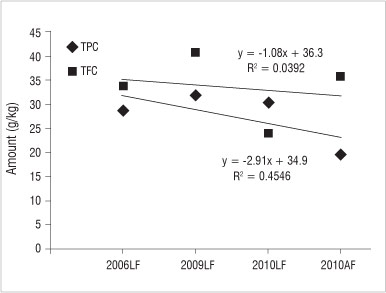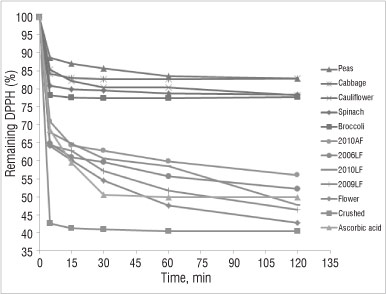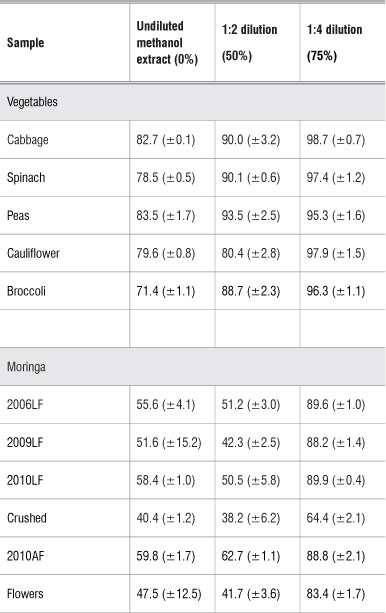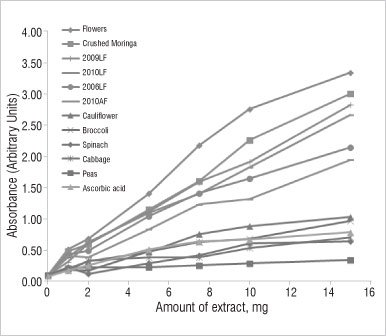Services on Demand
Article
Indicators
Related links
-
 Cited by Google
Cited by Google -
 Similars in Google
Similars in Google
Share
South African Journal of Science
On-line version ISSN 1996-7489
Print version ISSN 0038-2353
S. Afr. j. sci. vol.109 n.3-4 Pretoria Jan. 2013
RESEARCH ARTICLE
Comparison of antioxidant activity of Moringa oleifera and selected vegetables in South Africa
Vusumzi Pakade; Ewa Cukrowska; Luke Chimuka
Molecular Science Institute, School of Chemistry, University of the Witwatersrand, Johannesburg, South Africa
ABSTRACT
The antioxidant activity of the leaves and flowers of the Moringa oleifera plant were investigated and the results were compared to those of selected vegetables (cabbage, spinach, broccoli, cauliflower and peas). Antioxidant activity was determined by analysing the total phenolics content, total flavonoids content, reducing power and radical scavenging activity using the 2,2-diphenyl-1-picrylhydrazyl free radical method. The total phenolics content of moringa was almost twice that of the vegetables and the total flavonoids content was three times that of the selected vegetables. The reducing power of moringa was higher than that of the vegetables and the percentage of free radicals remaining was lower compared with the vegetables. These results combined show that moringa is a good source of antioxidants. This finding also explains why moringa forms part of the diet of people in many developing countries, especially in the southern hemisphere.
Keywords: phenolics; flavonoids; reducing power; 2,2-diphenyl-1-picrylhydrazyl; free radicals
Introduction
Humans are exposed to endogenous and exogenous sources of free radicals almost daily. These sources could be exposure to UV light, cigarette smoke, ionising radiation, certain organic solvents, pollutants and industrial waste or just metabolism.1 Free radicals are harmful as they can impact several metabolic pathways in cells. Oxidative species known for such harmful effects are the reactive oxygen species, reactive nitrogen species, hydroxyl radical and hydrogen peroxide. The presence of these free radicals in human beings might lead to degenerative diseases such as coronary heart disease, cancer and Alzheimer's disease.2 Therefore, consumption of antioxidants in food or as supplements can help protect the body against these diseases.3 A cup of coffee may contain 200-550 mg of polyphenols, while a cup of tea may contain about 150-200 mg of polyphenols and a glass of wine may contain about 200-800 mg of polyphenols.4 Natural antioxidants are recommended over their synthetic counterparts (butylated hydroxyanisole and butylated hydroxytoluene) because they are viewed as less toxic and more potent than synthetic antioxidants.1
Natural antioxidants such as vitamin C, tocopherols, flavonoids and other phenolic compounds are known to be present in certain plants.5 Moringa oleifera is one such plant that has been identified to contain natural antioxidants.6,7 Siddhuraju and Becker6 analysed the antioxidant activity of moringa from India, Nicaragua and Niger. Previously, Iqbal and Bhanger7 assayed the antioxidant activity of moringa from Nicaragua and their values were higher than those reported by Siddhuraju and Becker6. It is known that agroclimatic conditions can influence the chemical contents of plants.6 Hence, the antioxidant activity of the plant extracts can also be influenced by these agroclimatic conditions.
To the best of our knowledge, no other studies have been undertaken to determine the antioxidant activity of moringa grown in the Limpopo Province and in Atteridgeville (in Gauteng) in South Africa. Here we seek to share some of our preliminary results for the antioxidant activity of moringa grown in South Africa and compare them with the antioxidant activities of selected vegetables as well as those reported in the literature. Studies on moringa grown in South Africa are very important because the government, through the Department of Science and Technology, is encouraging the cultivation of moringa in communities. This study forms part of our ongoing research on moringa in South Africa,8 with the aim of providing evidence to support the use of moringa to curb malnutrition, particularly among disadvantaged communities in South Africa.
Experiments
Chemicals and reagents
Methanol, acetone, sodium nitrite, aluminium chloride, Folin-Ciocalteu reagent, gallic acid, 2,2-diphenyl-1-picrylhydrazyl (DPPH«), ferric chloride, ascorbic acid, quercetin, potassium ferricyanide and trichloroacetic acid were purchased from Sigma-Aldrich (Johannesburg, South Africa). Sodium carbonate and sodium hydroxide were purchased from Merck Chemicals (Johannesburg, South Africa). Ultrapure water (Milli-Q, Millipore, Randburg, South Africa) was used in all experiments and chemicals were used as received. The pH was adjusted with 0.1 M citric acid monohydrate and 0.2 M disodium hydrogen phosphate (both purchased from Sigma-Aldrich).
Sample collection and preparation
Moringa leaves and flowers
Fresh M. oleifera samples were harvested in April 2011 from two growing areas - Limpopo (LF) and Atteridgeville (AF) - in South Africa. The leaf samples were collected from trees that were planted in different years (2006, 2009 and 2010) and labelled as such, that is, 2006LF, 2009LF, 2010LF and 2010AF. A total of four moringa leaf samples were investigated. Immediately after collection, the leaves were immersed in a container of deionised water for about 1 min to remove surface contaminants. After freeze drying for a few days the samples were homogenised, ground into a fine powder using a commercial pulveriser (Fritsch pulverisette 6, Fritsch GmbH, Idar-Oberstein, Germany) and kept in a dark, cool place until further use. Moringa flowers were treated in the same way as the leaves, but were only collected from 2010LF trees. The material that passed through a 53-um sieve was used for extraction purposes. 'Crushed moringa' refers to moringa leaves from the Limpopo farm that were already packed for selling by the farm owner. These leaves were a mixture obtained from trees planted in different years.
Vegetable samples
Vegetables commonly consumed by South Africans (cabbage, spinach, broccoli, cauliflower and peas) were bought from a local supermarket in Gauteng. The inedible parts were removed with a sharp steel knife and about 1.0 kg of the remaining edible part of each vegetable sample was washed with tap water and cut into small pieces of approximately 1 cm x 1 cm. After lyophilisation, the samples were mixed well, homogenised and ground to a fine powder using a commercial pulveriser. Material that passed through a 53-um sieve was used for extraction purposes.
Determination of dry matter
For dry matter determination, about 3 g of freeze-dried leaf, flower or vegetable samples (in triplicate) were dried in an electric drying oven (Labotec Model 321, Umhlanga, South Africa) at 70 °C for 3 days until a constant mass was achieved.
Extraction of total flavonoids
Total flavonoids extraction was carried out using the method of Siddhuraju and Becker6. Briefly, 1 g of powdered freeze-dried leaf, flower or vegetable samples was extracted in an apparatus containing a round-bottomed flask and reflux condenser with 100 mL of 80% methanol for 3 h. After cooling, the extracts were centrifuged at 5000 rpm for 15 min, and filtered through 0.45-um filter paper. Finally, the volume of the extract was made up to 100 mL with 80% methanol. These extracts were used for the estimation of total flavonoids.
Estimation of total flavonoids
The method of Siddhuraju and Becker6 was followed with some modifications. A known volume of extract (0.3 mL) was placed in a 10-mL volumetric flask and distilled water was added to a total volume of 4 mL. To this volume was added 0.3 mL of NaNO2 (5 g in 100 mL) and the contents were mixed well. After 5 min, 3 mL of AlCl3 solution (1:100, wt/vol) was added. After a further 6 min, 2 mL of 1 M sodium hydroxide solution was added, and the total volume was made up to 10 mL with distilled water. The solution was mixed well again, and the absorbance was measured against a blank at 510 nm by a UV-visible spectrophotometer (Varian, Cary 50 Conc, Darmstadt, Germany). Quercetin (Sigma-Aldrich) was used as the standard for the calibration curve. The following linear equation based on the calibration curve was used to calculate the flavonoid content in the different methanol extracts of the samples:

Extraction of total phenolics
Extraction of phenolics from moringa leaves and flowers and the vegetable samples was carried out, with modifications, following the method reported by Siddhuraju and Becker6. Freeze-dried moringa and vegetable samples (0.25 g) were ground until they could pass through a 1-mm sieve size and extracted with 20 mL of 80% acetone using a sonication bath for 25 min. The resultant solution was centrifuged for 10 min at 6000 rpm and the supernatant saved. The residue was re-extracted as above, both supernatants were combined and total volume was made up to 50 mL with 80% acetone solution. The total phenolic content was estimated according to the Folin-Ciocalteu method using gallic acid as the standard.9
Determination of total phenolic content
Total phenolic content was measured in the acetone extracts of moringa leaves and flowers and in the vegetable samples using the Folin-Ciocalteu reagent assay. Briefly, 200 of extract was added to a freshly prepared solution of 750 Folin-Ciocalteu reagent (1:10) and 2 mL of 7.5% sodium carbonate. The final mixture was diluted by adding deionised water to a volume of 7 mL. The reaction mixtures were incubated at ambient conditions in the dark for 2 h to complete the reaction before the absorbances were measured at 765 nm by a UV-visible spectrophotometer (Varian, Cary 50 Conc, Darmstadt, Germany). All the experiments were conducted in triplicate. Gallic acid was used as the calibration standard and results were recorded as gallic acid equivalents (g/100 g of extract).
Free radical scavenging assay
The DPPH free radical scavenging activity assay was performed using a method adopted from Brand-Williams et al.10 with some modifications. Briefly, methanolic extracts of moringa or vegetables samples (0.1 mL, 1000 mg/L) were added to 3.9 mL of 0.025 g/L DPPH in methanol prepared daily. The decrease in absorbance was measured at 515 nm after 0 min, 5 min, 15 min, 30 min, 60 min and 120 min. The reaction mixtures were kept in the dark at room temperature between measurements. Furthermore, 50% and 75% dilutions of the extracts of each sample were prepared in methanol. These were treated as above but the absorbance was measured only after 60 minutes of incubation. The results are reported as a percentage of the DPPH concentration left in solution. Ascorbic acid, a known antioxidant, was used as a positive control.
Reducing power
The reducing powers of moringa and vegetable samples were determined according to the method described by Siddhuraju and Becker6. Lyophilised extracts of each sample (0 mg, 1 mg, 2 mg, 5 mg, 7.5 mg, 10 mg and 15 mg) in 1 mL of methanol were mixed with a 0.2 M phosphate buffer (5 mL, pH 6.6) and a 1% potassium ferricyanide (5 mL) solution; the mixture was incubated at 50 °C for 20 min. A volume of 5 mL of 10% trichloroacetic acid was added to each mixture, which was then centrifuged at 5000 rpm for 10 min. The upper layer of the solution (5 mL) was mixed with distilled water (5 mL) and 0.1% ferric chloride (1 mL), and then the absorbance was read spectrophotometrically at 700 nm. Higher absorbance indicates greater reducing power. Ascorbic acid was used as a control.
Results and discussion
Total phenolics and total flavonoids
The total phenolic content (TPC) and total flavonoid content (TFC) of dried moringa leaf samples from the two farms are given in Table 1. The contents of the moringa leaf samples were compared to those of selected vegetables as well as to values reported in the literature. The contents of moringa from the two farms were compared in order to determine whether the age of the plant influences the TPC and TFC. No correlation was observed between the TPC and TFC of the moringa leaves and the age of the plant (Figure 1). This finding could be because there are many other factors that also influence the contents, such as genetic variability, leaf age development and postharvest handling of the leaf samples.6 Postharvest handling may have had a greater influence in this case because the samples were transported by road for about 5 h on hot summer days.

Figure 1: Correlation between total phenolic content (TPC) or total flavonoid content (TFC) and age of the moringa plant.
It was observed that the TPC of the moringa samples was almost twice those of the selected vegetables, whilst the TFC of moringa was almost three times more than those of the selected vegetables. It is known that phenolic and flavonoid contents are directly linked to antioxidant properties.6 Therefore, moringa exhibited greater antioxidant activity than the selected vegetables. The TPC values of moringa found in this study were similar to those of moringa samples reported by Siddhuraju and Becker6, particularly for samples from India and Niger (Table 1). However, the TPC of moringa in this study was much lower than that of moringa from Pakistan7 (Table 1). A similar trend was observed for the TFC; the TFC of moringa in this study was similar to that reported by Siddhuraju and Becker6 but much lower than that reported by Iqbal and Bhanger7. These differences could be because the plants were exposed to different agroclimatic conditions.
Free radical scavenging activity
Figure 2 shows the antioxidant activity of the selected vegetable and moringa samples determined using the DPPH assay. DPPH generates free radicals; the assay measures the ability of various solvent extracts to scavenge these free radicals. The lower the concentration of DPPH free radicals in solution, the higher is the ability of that particular extract to scavenge free radicals. In the results shown in Figure 2, it can be observed that the order of scavenging activity (from low to high) was peas < cabbage < cauliflower < spinach < broccoli < 2010AF < 2006LF < 2010LF < 2009LF < moringa flower < crushed moringa. Therefore the moringa samples showed higher scavenging activity than the selected vegetables.

Figure 2: Percentage of DPPHradicals remaining after 120 min of incubation in undiluted methanol extracts of moringa and vegetable samples (p<0.05; n=3) and ascorbic acid.
The influence of the concentration of the extracts was also investigated by using three different concentrations: 0% dilution, 50% dilution and 75% dilution. The decrease in DPPH was measured after 60 min. Table 2 shows the percentage of free radicals remaining after incubation with each dilution. Generally, the percentage of free radicals remaining increased with an increase in dilution. However, even at the highest dilution (75%), moringa samples had fewer free radicals remaining than did the selected vegetable samples. Hence, moringa displayed greater antioxidant activity than the vegetables did. The scavenging ability of moringa was also higher than that of ascorbic acid, a known antioxidant.
Table 2: Percentage DPPH· radicals remaining after 60 min of incubation with Moringa oleifera and vegetable extracts at three different solvent concentrations

Values in brackets are %RSD, n = 3.
Reducing power of different solvent extracts
The reducing power of the extracts was measured by the ability of the extracts to donate electrons in order to facilitate the reduction of ferric ions (Fe3+) to ferrous ions (Fe2+). Different concentrations of sample extracts were charged with solutions containing Fe3+ and the absorbance was measured at 700 nm. This absorbance indicates the concentration of Fe2+ in solution, so the higher this absorbance, the higher the concentration of Fe2+ and the higher the ability of that particular extract to donate electrons, that is, the higher the reducing power of the extract. The higher the reducing power, the greater the antioxidant activity.6,11 Figure 3 shows the reducing power of the moringa and vegetable samples. Moringa extracts had higher reducing power than did the vegetable samples. The order of samples from lowest to highest reducing power is: peas < cabbage < spinach < broccoli < cauliflower < 2010AF < 2006LF < 2010LF < 2009LF < crushed moringa < moringa flower. A paired t-test comparing the 2010AF and cauliflower samples showed that the reducing power of the moringa sample was significantly higher than that of the cauliflower sample (t3=133, p=5.64x105). The reducing power of moringa was also higher than that of ascorbic acid.

Figure 3: Reducing power of moringa and vegetable extracts (p<0.05; n=3) and ascorbic acid.
The order for reducing power is similar to that for antioxidant activity determined by DPPH studies, except that the order for moringa flower and crushed moringa is reversed and the order for cauliflower and spinach is also reversed. In both investigations, peas and cabbage exhibited the lowest antioxidant activities. The TFC and TPC results were in agreement with those for radical scavenging ability and reducing power, that is, moringa samples showed greater antioxidant activity than did the vegetable samples. It may be that the phenolic content is related to the reducing power and the radical scavenging ability.6
Conclusion
Moringa leaves had almost twice the TPC and threefold the TFC of the vegetables. Reducing power and DPPH radical scavenging ability of moringa leaves were also much higher than those of the selected vegetables. These findings suggest that moringa is a better source of antioxidants than are common vegetables. We therefore recommend the addition of moringa to meals containing these vegetables to increase the nutritional value of the meals, especially for disadvantaged communities in South Africa. Moringa grown in South Africa contained similar amounts of total phenolics as moringa from Niger and India,6 but much lower amounts than moringa from Pakistan.7 These differences are attributed, among other factors, to agroclimatic conditions. Based on our results on antioxidant activity determined by TFC, radical scavenging ability and reducing power, moringa has good antioxidant properties, which suggests that the agroclimatic conditions in South Africa did not negatively affect the moringa samples.
Acknowledgements
This work was supported by the National Research Foundation and the Department of Science and Technology of South Africa.
Authors' contributions
All authors contributed to the research; V.P. performed the experiments.
References
1. Boonchum W, Peerapornpisal Y Vacharapiyasophon P Pekkoh J, Pumas C, Jamjai U, et al. Antioxidant activity of some seaweed from the gulf of Thailand. Int J Agric Biol. 2011;13:95-99.
2. Pezzuto JM, Park EJ. Autooxidation and antioxidants. In: Swarbrick J, Boylan JC, editors. Encyclopedia of pharmaceuticals technology. Vol. 1. 2nd ed. New York: Marcel Dekker Inc.; 2002. p. 97-113. [ Links ]
3. Moon J, Shibamoto T. Antioxidant assays for plant and food components. J Agric Food Chem. 2009;57:1655-1666. http://dx.doi.org/10.1021/jf803537k
4. Lakenbrink C, Lapczynski S, Maiwald B, Engelhardt UH. Flavonoids and other polyphenols in consumer brews of tea and other caffeinated beverages. J Agric Food Chem. 2000;48:2848-2852. http://dx.doi.org/10.1021/jf9908042
5. Laandrault N, Pouchert P Ravel P Gase F, Cros G, Teissedro PL. Antioxidant activities and phenolic level of French wines from different varieties and vintages. J Agric Food Chem. 2001;49:3341-3343. http://dx.doi.org/10.1021/jf010128f
6. Siddhuraju P Becker K. Antioxidant properties of various solvent extracts of total phenolic constituents from three different agroclimatic origins of drumstick tree (Moringa oleifera Lam.) leaves. J Agric Food Chem. 2003;51:2144-2155. http://dx.doi.org/10.1021/jf020444+
7. Iqbal S, Bhanger MI. Effect of season and production location on antioxidant activity of Moringa oleifera leaves grown in Pakistan. J Food Comp Anal. 2006;19:544-551. http://dx.doi.org/10.1016/j.jfca.2005.05.001
8. Pakade VE, Cukrowska E, Chimuka L. Metal and flavonol contents of Moringa oleifera grown in South Africa. S Afr J Sci. 2013;109 (3/4), Art. #835, 7 pages. http://dx.doi.org/10.1590/sajs.2013/835. [ Links ]
9. Makkar HPS, Becker K, Abel H, Pawelzik E. Nutrient contents, rumen protein degradability and antinutritional factors in some colour- and white-flowering cultivars of Viciafaba beans. J Sci. Food Agric.1997;75:511-520. http://dx.doi.org/10.1002/(SICI)1097-0010(199712)75:4<511::AID-JSFA907>3.3.CO;2-D
10. Brand-Williams W, Cuvelier ME, Berset C. Use of a free radical method to evaluate antioxidant activity. Lebensm Wiss Technol. 1995;28:25-30. http://dx.doi.org/10.1016/S0023-6438(95)80008-5
11. Yen GC, Duh PD, Chuang DY Antioxidant activity of anthroquinones and anthrone. Food Chem. 2000;70:437-441. http://dx.doi.org/10.1016/S0308-8146(00)00108-4
 Correspondence:
Correspondence:
Vusumzi Pakade
Molecular Science Institute, School of Chemistry, University of the Witwatersrand
Private Bag 3, WITS 2050, Johannesburg, South Africa
Email: vus7pakade@yahoo.com
Received: 29 Feb. 2012
Revised: 26 June 2012
Accepted: 28 Aug. 2012
© 2013. The Authors. Published under a Creative Commons Attribution Licence.














